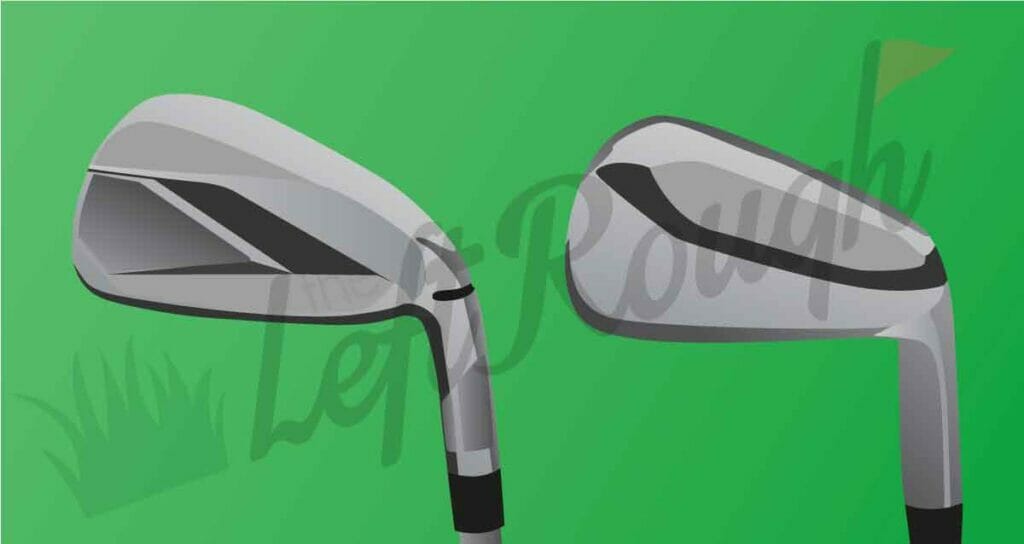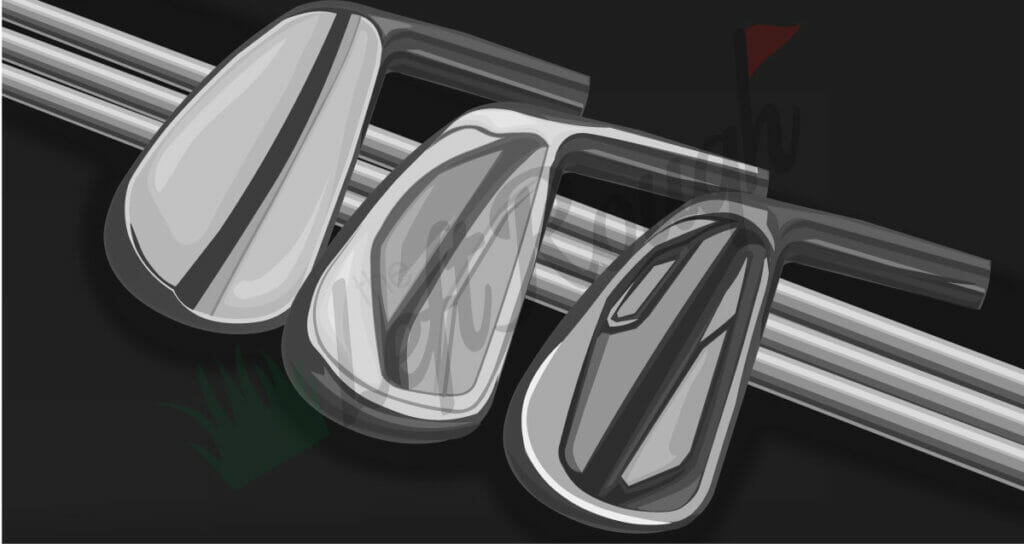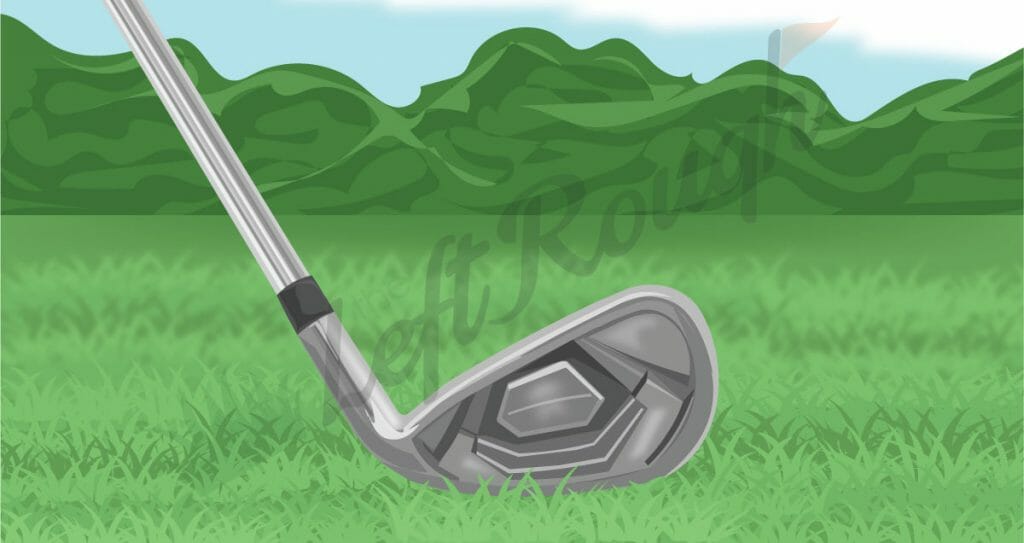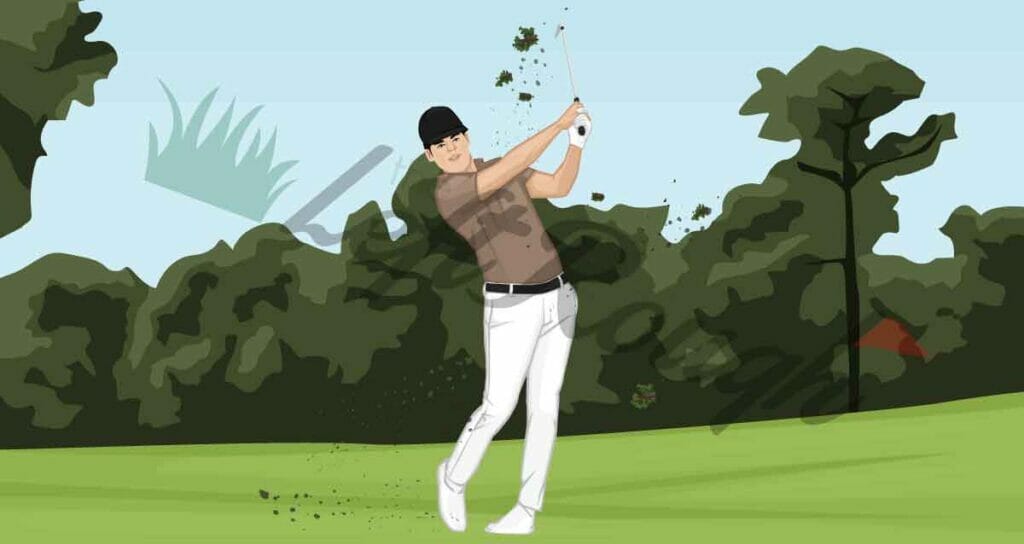If you’re like most people you’ve probably wondered if you should use forged vs. cast irons in golf. It’s a good question because playing the wrong equipment can hurt your scores and make a challenging sport even more difficult.
If you’ve played the game for more than 10 years you know how much equipment has changed over the years. Small persimmon woods are now 460 cc massive drivers.
Old sets of blade irons are replaced by larger, easier to hit clubs and some golfers avoid long irons entirely. Heck, even wedges and putters are more forgiving and easier to hit too.
Since your irons make up a majority of your bag, it’s crucial to find ones that match your game. Let’s get into the differences between cast and forged irons so you can use a set that makes golf easier.
Forged vs. Cast Irons in Golf
So, what makes a forged set of irons different from a cast set?
The manufacturing process as it’s drastically different with each type of set. We’ll explain both processes and explain how each type of iron is better for certain types of golfers.
Plus, get into how to find the right type of irons for your swing. We encourage you to watch this YouTube video from Mizuno Golf to learn more about the process of creating irons.
Key Takeaways
- A set of golf irons are either cast or forged and have a ton of differences between them.
- Forged irons are made with one piece of steel and tend to favor better ball strikers for a variety of reasons.
- Cast irons are a newer type of iron that favors more recreational golfers due to extra distance and forgiveness.
Keep reading to learn more about both types of irons now and see which set you need.
Forged Irons
The first main type of irons are forged irons which are older and more traditional in the golf world. Forged irons come from a single piece of steel that is heated to extreme temperatures, pounded repeatedly, and eventually formed into the iron shape.
The process starts with a billet (bar) of steel (usually 1025 or 1025E) and heated to high temperatures. Then they stretch and bend the steel to form the exact shape of the iron. It’s then inserted into the mold to make the shape of the golf club.
The air hammer press pounds the steel repeatedly to create the shape of the iron. Once the iron is shaped, the process moves into grinding to finalize the shape by smoothing out the edges.
Next, the grooves and numbers are added to the irons. Not to mention the polish as well as a lot of forged irons use Nickel Chrome. Once the iron head is complete the club gets a shaft (graphite or steel) and a grip so it’s ready for play.
Here are some of the benefits of these “one piece” irons.

Better Looking
The most noticeable difference between forged vs. cast irons is the look of them. It’s very easy to spot a difference between the two as forged are more blades or blade-like designs. While cast clubs are larger and tend to be more game-improvement (or super game improvement) irons that are better for higher handicap golfers.
Click here to learn the difference between blade vs. cavity backs.
Better Feel
Arguably the biggest benefit to using the forged process is the feel of the golf club.
The one piece design leads to fewer vibrations throughout the shaft when you hit the ball. Ultimately, this leads to more feedback with every swing and allows better golfers to shape shots easier.
If you’ve hit a cast iron vs. a forged iron as a consistent swinger of the club, you can tell the difference quickly! Feel is a very important part of golf and one of the reasons these clubs are used by better golfers.

Better for Shot Shaping
Aside from feel, forged irons also make it easier to shape shots in either direction. Better golfers like to hit both fades and draws which is needed to attack different pin locations. These irons are much easier to adjust the trajectory too.
Plus, shaping shots makes it easier to play in the wind as well. Needless to say, this is one of the biggest benefits for skilled players who want maximum workability vs. forgiveness.
Downsides of Forged Irons
While forged irons generally look better, feel better, and provide more workability to every shot, there are downsides. In golf, you typically have to give up forgiveness to enhance workability and that’s exactly what happens with forged irons. These one-piece irons are much less forgiving as the sweet spot is much smaller.
The majority of the weight (center of gravity) is directly behind the sweet spot. This makes your good shots better but hurts off center hits. Since there isn’t as much behind the toe or heel, these irons aren’t nearly as forgiving.
Another downside to forged irons is the price tag; these clubs are significantly more expensive than cast irons. Due to the production process, forged irons cost much more than cast irons which can make an expensive game cost even more.
Lastly, forged irons don’t tend to have the same durability as cast clubs.
Cast Irons
Cast irons are a newer type of irons that didn’t come around until the mid 1970s. These irons are not pounded out from one piece of steel like forged irons. Instead, these are created by molten metal that is poured in a pre-made mold for the shape of the irons.
The molten metal production process is night and day which has a big impact on the performance of the golf clubs. As mentioned in the YouTube video from Mizuno above, casting happens from turning a liquid into a solid. The problem with casting is that the material can shrink and air bubbles can happen during the casting process.

Since forged clubs are from one piece of steel, this isn’t an issue and one of the major differences. Once the cast iron has cooled, the hosel, shaft, and grip are installed to make them ready to go. Here are some of the benefits of cast irons in golf.
Much More Forgiving
As you can imagine, this process makes these irons much more forgiving than forged irons. Since the irons are thicker, they reward mishits much greater than forged irons. Even if you hit a shot off the toe or heel, you can still get away with it thanks to the thicker clubhead design.
More Ball Speed
Another perk of using cast irons is that they tend to produce faster ball speeds, which means more distance on every shot. Thanks to the design the steel is much harder than the forging process which helps increase the speed of the ball off the face.
For beginners, mid-handicappers, and senior golfers, this is a massive benefit. Not only are these irons more forgiving but they’re longer too. This makes it easier to hit more greens and hopefully have fewer shots at the end of the day.
Lower Cost
Since the process is much more automated than the forging progress, cast irons are cheaper to make as well. Lower production costs means lower prices for the consumer (aka golfers) which we can’t complain about. Cast irons can save you hundreds of dollars on your iron set!
Downsides of Cast Irons
Like forged irons, there are some downsides to cast irons as well. Arguably the biggest downside is that cast irons don’t have the same feel of forged clubs.
If you hit a cast iron then a forged iron as a skilled player you will feel the difference. But as a mid to high handicapper you’ll also feel the difference as forged clubs are much harder to hit. This lack of feel makes it harder to get feedback on shots and/or play both fades and draws.

How to Decide Forged vs. Cast Irons
There are a lot of myths and misconceptions about forged vs. cast irons. Let’s debunk a few to see which is right for your game.
Skill Level
The biggest thing to think about when buying a new set of golf irons is your skill level. You need to use a set of clubs that are right for your swing. Too many golfers use equipment that is too good (or not good enough) for their skill level and scores suffer as a result.
If you’re a solid ball striker with higher swing speeds and more consistent ball striking, you can benefit from forged irons. But the good news is that cast irons have improved in recent years thanks to A.I. and other technology. This makes cast irons much better than older irons and most golfers will likely play a version of casted clubs.
Budget
The other big factor when picking your new set of irons is price; forged irons cost substantially more due to the design process. Needless to say, you’re paying more for less forgiving clubs so make sure they’re right for your game.
Schedule a Custom Fitting
As you can tell, there is a lot to think about when it comes to buying a new set of irons. Instead of guessing and testing, we recommend for a lot of players to do a custom fitting. This will ensure you don’t waste your money and buy the right clubs for your swing.
A club fitter can help you compare irons, test out different shafts, and use a launch monitor to identify the best clubs for you. Plus, they can easily adjust the lie angle of your current irons and/or a new set of golf irons too. Because even if you play the right irons you need to make sure they’re the correct angel to avoid pushes and pulled shots.
Click here to learn more about custom fittings in golf.

FAQs About Irons in Golf
Do you have more questions about using the right set of irons? If so, keep reading to learn more from the most frequently asked questions and answers below.
Which is better: cast or forged irons?
One isn’t necessarily better than the other as it depends on the type of golfer.
More advanced golfers will benefit from forged irons and less skilled golfers will benefit more from cast irons. But don’t forget that forged irons harder to hit!
What is the advantage of forged irons?
Forged irons provide better feel and thus, more workability than cast irons. This is why PGA Tour players and elite amateurs prefer forged vs. cast irons.
These clubs allow them to alter trajectory and ball flight to hit all types of shots. But as mentioned above, there are plenty of disadvantages to using forged irons too.
Are forged clubs harder to hit?
Yes, forged clubs are less forgiving than cast irons.
This is because the majority of the weight is directly behind the sweet spot as the clubs are formed from one piece of steel. This leaves less forgiveness on the toe or heel which makes your mishits much worse.
Forged golf clubs almost force you to become a better golfer, likely why older players prioritized ball striking. Otherwise, mishits were so bad that it made scoring well very difficult.
But now a lot of golfers don’t have to “dig it out on the driving range” working on their swing as they can use cast irons instead. It’s safe to say that ball striking legend Ben Hogan wouldn’t approve of these forgiving cast irons.
Why can’t I hit a forged iron?
Forged irons are less forgiving than cast irons because of the design. There isn’t as much weight behind the heel or toe so mishits are much more noticeable in terms of distance.
Can a high handicapper play forged irons?
A higher handicapper will generally fare better with cast irons but it’s not a blanket answer. A lot of people think that only scratch golfers or players who break 80 can play these types of irons.
But it’s not true 100% of the time. In general, yes forged irons are for more consistent ball strikers but it’s not a hard and fast rule.
Go here to see our favorite irons for beginners and high handicappers.
Plus, it’s not like you start shooting 79 and then the Golf Gods say – “Okay, it’s time to switch to forged golf clubs now.” Instead, it’s about finding the right type of irons and correct shafts that match your swing speed.

Which irons are hardest to hit?
Design wise, the hardest irons to hit are blades which are forged clubs. These irons look sexy but are by far the hardest to hit well.
Older models of blades looked more like butter knives and required precision by golfers to make solid contact. Since the club heads were so small, mishits are not rewarded to say the least.
In terms of hardest to hit irons, the most challenging to hit consistently well are long irons. Longer irons are hard for most golfers to hit consistently due to the lack of forgiveness and smaller clubhead. This is why a lot of golfers opt to use fairway woods, hybrids, or driving irons instead of traditional long irons.
Click here to learn how to hit long irons better.
What’s the difference between forged wedges and cast wedges?
The same thing as irons – forged wedges are harder to hit consistently for most golfers. Luckily the golf industry introduced cast wedges in recent years to make a wedge club head more forgiving too. This perimeter weighting makes the golf club easier to hit and a great idea if you play forgiving irons too.
My Experience
I’ve been all types of golfers in my 20+ career – from a 30 handicap all the way to a +2 handicap. While I’ve never consciously thought about playing forged or cast irons I can say clubs make a big difference. As you progress through your golf career it’s essential to play equipment that suits your swing.
Don’t forget, forged irons are harder to hit and you can still play great golf with cast irons. The overwhelming majority of iron sets are cast these days. Heck, even the pros play with some cast irons (usually longer irons) so don’t let your ego get in the way of buying the right clubs.
What are the best forged irons?
Some of the best forged irons come from Mizuno (who has been making forged irons in the same factory since 1968. Other brands that make solid piece forged golf clubs include Srixon, TaylorMade, and Titleist.
Final Thoughts on Different Type of Club Heads
Forged and cast irons both have their benefits for certain types of golfers. Luckily, you don’t need a forged club set anymore if you don’t have a consistent swing. Cast heads will help you hit the golf ball longer and straighter, even if you don’t have a consistent swing.
Here is a quick recap of cast and forged irons:
- Forged clubs feel softer than cast irons due to the design process.
- Forged heads are harder to hit and not recommended for high handicappers.
- A forged iron happens from a solid piece of steel and then pounded into the desired shape.
- Cast irons (cavity backs) have a predetermined head shape mold where hot metal is converted into its shape.
Overall, the average golfer and high handicappers should take advantage of what are considered game improvement irons. These pieces of golf equipment will make the game easier and allow you to hit more solid shots.
Lastly, don’t forget to play the right shafts either, regardless of which style of head.
Check out some of our most popular iron articles below to get your game dialed in:

